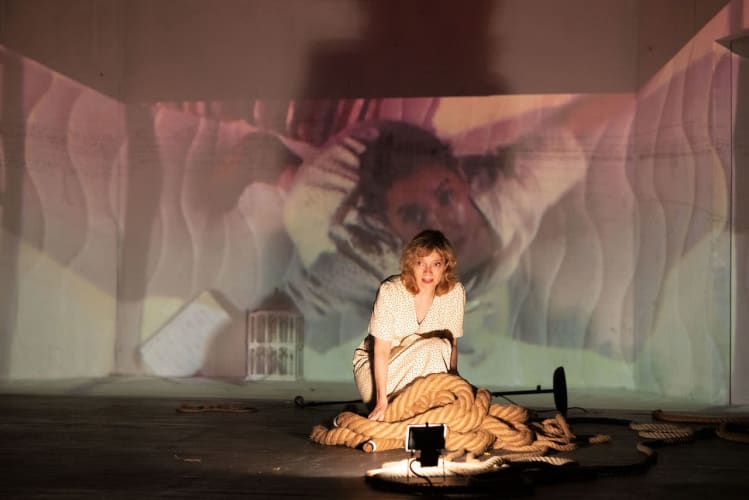The Yellow Wallpaper is a highly charged and emotionally perturbing story of female oppression told through text, dance, sound design and live video to create a palace of the senses that outwardly express troubled inner turmoil.
No easy feat, but in one hour, this production lures the audience into the merry-go-round, hysterical world of a young women clearly in denial, who crumbles as the performance unfolds, making her appearance all the more fragile as she appeals to the audience with haunted blue eyes and hysterical scribbling on the very walls that confine her.
The performance is based on American early feminist Charlotte Perkins Gilman’s pioneering 1892 classic novella The Yellow Wallpaper. In the book, a young mother is held captive, locked into a room on a country estate by her physician husband, most likely suffering from postnatal depression, confused with hysteria. The best cure for the unassuming women is to be locked up and rendered invisible from society. It is here, in her cell-like environment, where she becomes obsessed with the yellow wallpaper in the room.
The staging of the tale, closely observed and directed by Stephanie Mohr, recreates the first-person narrative, played by Aurelia Thiérrée, while a live video feed of dancer and choreographer Fukiko Takase dancing, writhing and jumping on a sordid mattress is projected on a giant screen behind her.
A cluttered set, full of remnants of a past life, offers a curious playground of oddities from an old pram, mattress, coils of thick ropes placed around the stage and billowing ghostly white nightgowns hanging from the beams of the theatre, create a hallucinatory atmosphere.
Backed by an intriguing text, it is impossible not to get swept into the turmoil of the central character. On the one hand, the nameless woman talks continuously about her husband, John, as if he has her best interests at heart. Yet as the narrative unfolds, echoes of fear and coercion creep into her language as she confides that John would be angry if she continues to ask for a prettier room with roses around the window frame. Or, she tells us, she is sure that work would be good for her, make her feel better, but her husband won't allow it.
As the play approaches its climax, hysteria builds and Thiérrée savagely tears the paper off the walls in frenzied motion. Finally, the dancer is released from behind the screen and the woman finds some form of freedom in the prison cell of madness. Both women are necessary to make this drama work. Thierrée’s acting is hauntingly persuasive and Takase’s movement creates a powerful physical constancy alongside her ethereal female protagonist who, without this life force beside her, could wither into the wallpaper and disappear into complete nothingness.
When the sensory overload, from sounds of crying babies, birds and giant video projections, all draw to a close, the audience are left simply with the powerful outreaching eyes of Thiérrée, who appeals to us, walking downstage and up close, to save her from her fate. Thierrée combines a luring tone of wide-eyed innocence and certainty that the powers that be have her best interests at heart even though we know the odds are stacked against her.
Perhaps it is in the intimate moment of the finale where the real power of performance lies. Stripped of all hyper-stimulating props and a busy stage, we are left looking a lonely woman, a broken soul reaching out for answers and finding nothing but emptiness.
